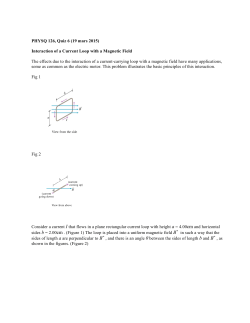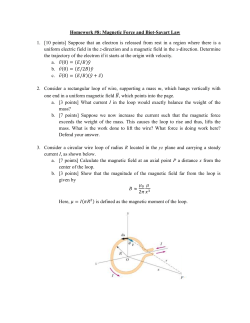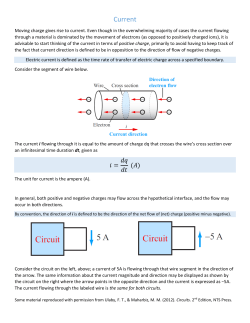
Ampere`s Law
Ampere’s Law Draw a closed loop L anywhere in 3D space and consider a line integral of the magnetic field B(x, y, z) along that loop, IB [L] = I Bk dℓ. (1) L where dℓ is the length differential along the loop L and Bk is the component of the magnetic field along the loop. In vector notations, IB [L] = I B(r) · dr. (2) L The Ampere’s Law relates this loop integral to the net electric current through the loop: In MKSA units I B(r) · dr = µ0 × I net [through L], (3) 4π × I net [through L]. c (4) L while in Gauss units I B(r) · dr = L Sign convention: for a clockwise loop, a current flowing into the loop counts as positive while a current flowing out from the loop count as negative. For a counterclockwise loop, the signs are opposite: a current flowing into the loop is negative while a current flowing out 1 from the loop is positive. Example: a counterclockwise circle in the (x, y) plane: z y x This loops looks counterclockwise when viewed from above, so currents flowing Up appear flowing out from the loop and thus count as positive, while currents flowing Down appear flowing into the loop and thus count as negative. Hence, for this loop, I net is the net current through the loop in the upward direction. Application of the Ampere’s Law In many symmetric situations, the Ampere’s Law gives us the magnetic field without any hard calculations. Trivial Example: A long straight Wire. Consider a long straight wire running along the z axis and carrying current I in the +z direction (Up). By symmetry, the magnetic field of this current depends only on the distance p x2 + y 2 from the wire in the transverse (x, y) plane, and the direction of this magnetic field is circular around the wire. In the cylindrical (ρ, φ, z) coordinates, B(ρ, φ, z) = B(ρ) ×~ıφ . (5) To find the radial dependence of this magnetic field we may use the Ampere’s Law. Let L 2 be a circular loop or radius R in the (x, y) plane centered on the wire. Then along the loop, dr = R dφ ×~ıφ , (6) B(r) · dr = B(ρ = R) × R × dφ (7) hence and therefore I B(r) · dr = B(R) × R × I dφ = B(R) × R × 2π. (8) L By Ampere’s Law, this integral is equal to µ0 × I, thus B(R) × 2πR = µ0 × I (9) and therefore µ0 × I . 2πρ B(ρ) = (10) Note: it does not matter if the wire in this example is thin or thick. As long as we are outside the wire, the magnetic field is given by eq. (10) in terms of the net current I through the wire. Example: Magnetic Field Inside a Round Wire Now consider a round wire of finite thickness Rw and let’s find the magnetic field inside the wire. This example has the same cylindrical symmetry as our first example, hence in cylindrical coordinates B(ρ, φ, z) = B(ρ) ×~ıφ , (11) but this time we have a different radial dependence of B(ρ for ρ < Rw (inside the wire) than for ρ > Rw (outside the wire). 3 To see the difference, consider a circular loop L of radius ρ centered on the wire: ρ > Rw wire L L ρ < Rw For ρ > Rw the loop L completely surrounds the wire, hence the net current through the loop is the same as the net current in the wire, I net [through L] = I. for ρ < Rw , (12) On the other hand, for ρ < Rw the loops surround only a part of the wire, so only a fraction of the whole curent I flows through the wire. Assuming uniform current density in the wire, J = I , 2 πRw (13) the current flowing through the loop L is I[through L] = J × A[L] = J × πρ2 = I × ρ2 2 Rw (for ρ < Rw ). (14) For both kinds of loops, the Ampere’s Law + cylindrical symmetry give us I B(r) · dr = 2πρ × B(ρ) = µ0 × I[through L], (15) L hence for ρ > Rw , but for ρ < Rw , µ0 × I , 2πρ µ0 × I µo × I ρ2 B(ρ) = × ρ. × 2 = 2 2πρ Rw 2πRw B(ρ) = 4 (16) Graphically, B(ρ) ρ Rw Proof of the Ampere’s Law Now let’s derive the Ampere’s Law from the formula B(ρ, φ, z) = µ0 × I ×~ıφ 2πρ (17) for the magnetic field of a single straight wire and the superposition principle for multiple wires. Let’s start with a single straight wire along the z axis but allow for loop L of arbitrary shape and location in 3D space. Along such a loop, dr = dz ×~ız + dρ ×~ıρ + dφ × ρ~ıφ , (18) hence for the magnetic field (17) of a straight wire, B(r) · dr = µ0 × I µo × I × ρ dφ = × dφ 2πρ 2π (19) and therefore I µ0 × I B(r) · dr = × 2π L The remaining integral here H I dφ . (20) L dφ is purely topological and depends only on how many times the loop L wraps around the wire. In particular, if the loop does not wrap the wire at all, 5 we may treat the angular coordinate φ along the loop as single-valued, which leads to I dφ = φfinal − φinitial = 0. (21) L More generally, for L which wraps around the wire N times in the counterclockwise direction (as viewed from above), I dφ = φfinal − φinitial = N × 2π (22) L and therefore I B(r) · dr = µ0 × I × N. (23) L Likewise, for a loop which wraps around the wire in a clockwise direction I dφ = φfinal − φinitial = −N × 2π (24) L and therefore I B(r) · dr = µ0 × I × (−N). (25) L Finally, for a loop wrapping back and forth around the wire, I B(r) · dr = µ0 × I × Nnet (26) L where Nnet is the net number of counterclockwise − clockwise turns. In terms on the net current through the loop, I net [through L] = I × Nnet , (27) hence I B(r) · dr = µ0 × I net [through L]. (28) L Now consider multiple wires carrying currents Ii . The loop L surrounds some wires but not the others, and it might surround some wires multiple times. Let Ni be the number of 6 times L surrounds the wire#i in counterclockwise − clockwise direction, with Ni = 0 for the wires which are not surrounded by the L. Then X I net [through L] = Ni × Ii , (29) i At the same time, by the superposition principle Bnet (r) = X Bwire#i (r) (30) i and hence I Bnet (r) · r = XI i L = X Bwire#i (r) · r L (31) µ0 × Ii × Ni i = µ0 × I net [through L]. Differential Form of the Ampere’s Law Now suppose instead of discrete wires we have a continuous electric current density J(x, y, z). In this case, the net electric current through some closed loop L obtains as a flux of J through a surface S spanning the loop L, I net [through L] = ZZ J · dArea . (32) S In this formula, S is any surface which is topologically a disk and whose only boundary is the loop L, for example S L L 7 By Ampere’s Law, this current through L is related to the line integral of the magnetic field around L, I B(r) · dr = µ0 × I net [through L] = µ0 × ZZ L J · dArea . (33) S At the same time, by the Stokes’s curl theorem, the same line integral of B is related to the surface integral of the curl ∇ × B, I B(r) · dr = L ZZ S ∇ × B · dArea , (34) hence ZZ S ∇ × B · dArea = µ0 × ZZ J · dArea . (35) S Note: both surface integrals here are over the same surface S which spans the loop L. By varying the loop L, we can make S to be any surface we like, as long as its topology is a disk. In particular, we may take S to be a tiny surface of infinitesimal area dA located near arbitrary point r, in which case eq. (35) reduces to ∇ × B(r) · dA = µ0 J(r) · dA. (36) Since this equation must hold for any infinitesimal dA and any location r, it leads to the field equation ∇ × B(r) = µ0 J(r). (37) This field equation is the differential form of the Ampere’s Law in MKSA units. In Gauss units, the differential form of the Ampere’s Law is ∇ × B(r) = 8 4π J(r). c (38) Current Sheets A current sheet is electric current flowing along some 2D surface. Thanks to the Ampere Law, current sheets cause discontinuities of the magnetic field B(r). That is, as r approaches the same point on the current sheet from two different sides, the magnetic field B(r) has different limits. This is similar to the discontinuity of the electric field caused by surface charge densities, but the component structure in the magnetic case is quite different. To see how this works, consider a flat current sheet in the (x, y) plane at z = 0. The electric current flows in the +y direction along the sheet, while the linear density of the current in x direction is uniform, j = I[within ∆x] = const. ∆x (39) Such a current sheet may be approximated by a uniform array of parallel wires: y ˆI ˆI ˆI ˆI ˆI ˆI ˆI ˆI ˆI ˆI ˆI ˆI ˆI ˆI x Each wire runs in the y direction and carries the same current ˆI, and there is a uniform density N/L of wires in the x direction. The effective linear current density for this array is N j = ˆI × . L (40) Now let’s look at the magnetic field above or below such a current sheet (or wire array) 9 in z direction. The Bx component of the field — parallel to the sheet but ⊥ to the current — has a discontinuity Bxabove − Bxbelow = µ0 × j. (41) Indeed, let’s apply the Ampere’s Law to a rectangular ∆x × ∆z loop in the (x, z) plane which surrounds a bit of the current sheet (or some of the wires): z L x For small ∆x and even smaller ∆z ≪ ∆x, the line integral of the magnetic field over this loop becomes I B · r = Bxabove × ∆x − Bxbelow × ∆x (42) L where opposite signs of the two terms on the RHS is due to opposite directions of the loop L above and below the current sheet. At the same time, the current surrounded by the loop is I[within L] = j × ∆x, (43) B · r = µ0 × I[within L] (44) so the Ampere’s Law I L gives us Bxabove × ∆x − Bxbelow × ∆x = µ0 × j × ∆x. (45) Dividing both sides of this equation by ∆x, we arrive at the discontinuity formula Bxabove − Bxbelow = µ0 × j. 10 (41) Note: if the only source of the magnetic field is the flat current sheet in question, we may combine the discontinuity (41) with symmetries to obtain the whole magnetic field: z Babove = + µ0 j ~ıx 2 x (46) Bbelow = − µ0 j ~ıx 2 When there are additional sources of magnetic fields, we cannot directly determine the Babove and the Bbelow , but the Ampere’s Law always tells us the discontinuity of the magnetic field across the current sheet. Moreover, the discontinuity is local and depends only on the linear current density right on the current sheet and does not care of any distant magnets or wires. So the same discontinuity (41) applies when the current sheet is curved rather than flat, or even if the current density is non-uniform. If we define the local discontinuity at point r on the current sheet as disc B(r) = lim r′ →r from above B(r′ ) − lim r′ →r from below B(r′ ), (47) then disc B(r) = −µ0 n(r) × j(r) (48) where n(r) is the unit normal vector to the current sheet at point r and j(r) is the linear current density at that point. Note the vector product: that’s what turns a current in y direction into a discontinuity of the Bx . 11 Solenoid A solenoid is helical coil of a wire. Generally, the wire makes many tight coils around some cylindrical tube as shown on the above picture; sometimes the coils make several radial layers to increase the turn density N Nturns = . L Length (49) Locally, the many turns of the wire act as so many parallel wires, each carrying the same current I, so the whole wall acts as a cylindrical current sheet with linear current density j = I× N . L (50) By Ampere’s Law, this current sheet cases discontinuous magnetic field, inside outside ∆B = Bsolenoid − Bsolenoid = µ0 × I × N . L (51) The direction of this discontinuity is along the current sheet — i.e., along the cylindrical wall of the solenoid — but ⊥ to the current which flows in circles around the cylinder. In other words, the direction of the ∆B is along the long axis of the solenoid. 12 To go beyond the discontinuity, we need a bit of field line geometry. For a long, thin solenoid, the magnetic field lines outside the solenoid spread out in all 3 dimensions, so the magnetic field outside the solenoid’s wall is fairly weak. On the other hand, the field lines inside the solenoid are mostly confined to the solenoid’s tube and cannot spread our, so the magnetic field inside the solenoid is much stronger than outside it. Consequently, the discontinuity across the solenoid’s current is dominated by the inside field, inside outside inside ∆B = Bsolenoid − Bsolenoid ≈ Bsolenoid , (52) so we may use the discontinuity to approximate the inside field. Thus, the magnetic field inside a long thin solenoid is B = µ0 × I × 13 N . L (53) For example, inside a tightly wound solenoid with N = 120 loops/cm = 12, 000 loops/m, L (54) a 50-ampere current creates magnetic field B = 4π · 10−7 T m/A × 50 A) × 12, 000 m−1 ≈ 0.75 T. (55) The direction of the magnetic field inside a solenoid is given by the right screw rule: turn a screw in the direction of the current, and the screw’s linear motion would indicate the direction of B. This, if you are looking along the solenoid’s bore and see the current flowing clockwise then B points away from you, but if the current flows counterclockwise then B points into your face. 14
© Copyright 2025









